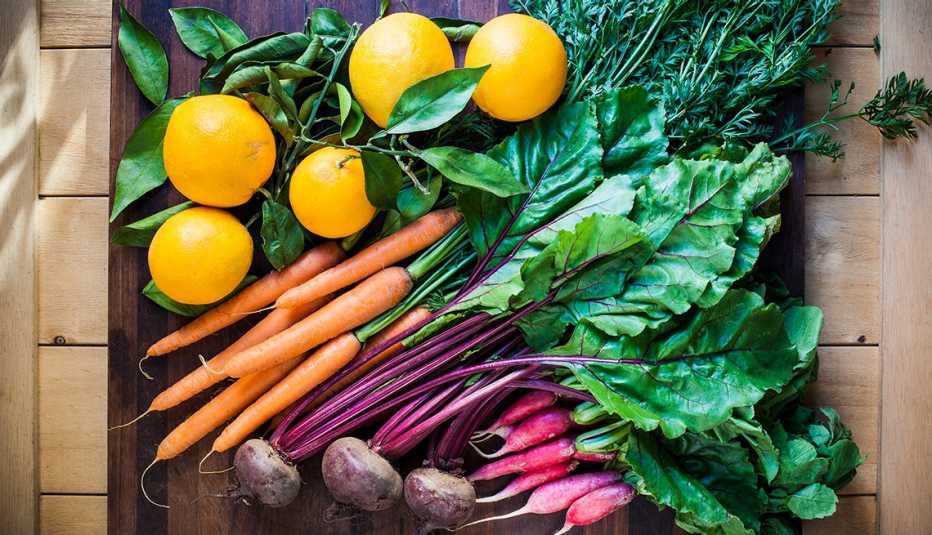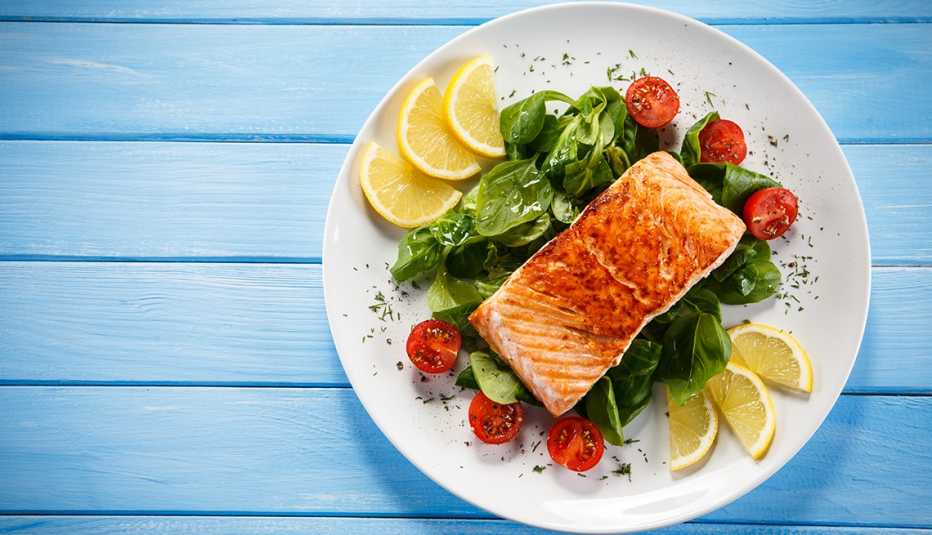AFTERNOON
8. Have fish for lunch
Heart-healthy omega-3 fatty acids act like a spa vacation for your arteries — reducing high blood pressure, nurturing artery walls, lowering heart-menacing triglycerides and even cooling inflammation.
But don’t buy the marketing hype about fish-oil capsules; several large studies have found few benefits. Start with fish. The American Heart Association recommends at least two 3.5-ounce servings a week, especially of fatty fish. It makes a difference. When Tufts University researchers tracked blood levels of a potent omega-3 fatty acid found in fish called EPA in 2,622 older adults for 22 years, they found high levels linked to 24 percent lower odds for “unhealthy aging” — including heart attacks and heart failure. While those fish lovers ate about 2.3 servings of seafood a week, the typical older U.S. adult gets a little more than one ounce of heart-friendly fin food per week.
It’s time to change that with a trip to the canned foods aisle. Canned salmon, canned tuna and canned sardines are good sources of omega-3 fatty acids that are quick, affordable and convenient, Patton says. Toss with a little mayo, some relish or mustard and your favorite mix-ins (grated carrot and corn kernels add juicy crunch). Bake into a quiche. Or enjoy sardines, mackerel or herring on whole-wheat crackers.
9. Add red, green and blue crunch
Boost your produce tally and supply your heart with protective phytonutrients. Toss together two cups of leafy greens, a cup of cherry tomatoes and a splash of olive oil. Sprinkle with blueberries and a few chopped pecans for crunch. Daily greens lowered heart risks 26 percent in that big Spanish study, while vegetables rich in lycopene (like tomatoes) reduced risk 25 percent. (Lycopene battles plaque and inflammation.) Eating berries three times a week cut heart attack risk 32 percent — perhaps thanks to purplish-blue compounds called anthocyanins that help keep arteries flexible, which can help control blood pressure. The nuts? They deliver fiber, nutrients and good fats, Patton says.
10. Log 1,000 easy, extra steps
Add a little hustle to your everyday activities: Stroll around the house for five minutes every hour when you’ve been sitting at the computer or watching TV, sweep the hallway in addition to the kitchen, take out the trash, volunteer to walk Fido (he’d love to circle the block twice). It all counts as extra steps your heart craves. These activities could easily add 1,000 extra steps to the daily count your smartphone is probably keeping (check your health app to see). It’s the amount that lowered cardiovascular trouble by 5-21 percent in a 2020 Duke University review of 17 studies of more than 30,000 adults.
“What’s important is to be very cautious about how long we’re sitting,” Balfour says. “Too many hours without any movement isn’t good for your heart. Your body needs to move throughout the day. Anything that gets your heart rate up, even a little, helps. Take a couple of 10-minute walks. Play with your kids or pets. Do some yard work.”
11. Snack smarter
Prep a sweet, savory or crispy snack that’s heart-friendly — and give junk food the boot.
Eating lots of ultra-processed foods such as many packaged cookies, cakes, pies and chips, boosted risk 58 percent for dying early from heart disease in a 2021 Italian study that followed 22,475 adults, around age 55, for eight years.
The shocking side story: Ultra-processed foods were a potent heart threat even for people who otherwise followed a healthy diet! More sobering news: The average American gets 58 percent of their daily calories from ultra-processed Frankenfoods, a category that also includes soft drinks and many types of ready-to-eat pizza, soups and frozen meals. Snacks are a big source. Patton suggests slipping the processed-food trap by creating your own grab-and-munch snacks, such as carrot sticks and hummus, grapes, cherries, raspberries or dark chocolate and nuts.
EVENING
12. Have a hearty dinner
Start a pot of chili, a hearty bean soup … or grill a bean-based burger. The fiber, nutrients and plant compounds in beans make these meat alternatives great for your heart; the protein they pack makes beans a satisfying centerpiece at dinner time, Patton says. A cup of black beans, for instance, delivers 15 grams each of protein and fiber, along with cell protecting antioxidants that may explain why people who ate the most beans had a 10 percent lower chance of cardiovascular disease in a 2017 Italian review of 17 studies involving 18,475 people.
If you’ve tried bean burgers in the past and not been impressed, Patton recommends choosing another from the many brands in the frozen-food aisle. (Look for one that’s lower in sodium). There are so many out there, you’re bound to find one you like. Slide it onto a whole-grain bun, add your favorite toppings and enjoy. While the USDA recommends adults munch 3 cups of beans per week, most of us get less than a cup. Bumping up your beans could reduce heart disease risk up to 10 percent and high blood pressure by 9 percent, finds a 2019 review of legume benefits.
13. Stre-e-e-tch
Moves that stretch out your muscles — like gentle yoga or sitting on the floor or on a sturdy chair to stretch out your thigh and calf muscles — could do your blood pressure some good, too.
In a recent Canadian study of older adults with above-normal blood pressure, a daily stretching routine reduced blood pressure readings as much as seven points. Why it works: Lead researcher Phil Chilibeck , professor of kinesiology at the University of Saskatchewan, and his team say stretching your muscles also stretches arteries, improves blood flow and activates the parasympathetic nervous system that regulates the body’s relaxation response. People in the study stretched for 30 minutes a day, five days a week, for eight weeks. But Chilibeck says yoga or a few moves that stretch major leg muscles (you can do them while you watch TV) could have similar effects.
14. Click off devices two hours before you turn in
Turn off your smartphone, laptop and tablet computer (or switch the light setting to night mode or put on blue-light blocking glasses) at least two hours before bed, suggests sleep researcher Jessica R. Lunsford-Avery. Blue light emitted by devices with backlit screens suppresses secretion of the hormone melatonin, which regulates sleep and, it turns out, may also protect arteries and the heart by regulating blood fats and blood sugar and by curbing inflammation and protecting against cell damage. Your brain and body clock are especially sensitive to blue light at night; blocking it for two hours before bed improved sleep length and quality in a small 2017 Columbia University study of eight women with insomnia. (They wore light-blocking glasses.)
15. Set an early bedtime
Plenty of shut-eye is good for your heart, Lunsford-Avery says. “A lot of research suggests that short sleep places adults at risk for cardiovascular problems,” she notes.
Getting less than seven to nine hours per night makes artery walls less supple and more likely to clog with plaque, according to a 2021 University of Florida review, for instance. Good sleep meant a 42 percent lower risk for developing heart failure in a 10-year UK study of 408,802 women and men, ages 37 to 73, published in 2021. Instead of catching up with social media, work, the news or your favorite reality show, wind down with a warm shower — it helped people fall asleep faster and boosted sleep quality in a 2019 University of Texas at Austin study.
“When you don’t get enough sleep or get poor-quality sleep, you’re at increased risk for overweight, diabetes, high blood pressure, heart disease and stroke,” Balfour says. “Get at least eight hours each night.” A cool, quiet bedroom and a relaxing bedtime routine help. So does turning off notifications on your smartphone before you turn in, so you’re not roused by every tweet, instant message and email that rolls in. “You may not notice, but your body does,” he says. “That interrupts sleep.”
WEEKENDS
16. Alleviate work stress
In large studies, work-related stress boosted odds for cardiovascular problems 40 percent, and feeling stressed, regardless of the cause, increased risk for fatal heart disease 27 percent, according to a landmark 2021 American Heart Association report. Anger, anxiety, depression and pessimism all affeact the heart and arteries.
One reason is that they’re linked to higher odds for heart risks like obesity and lack of exercise, says cardiologist Glenn Levine, M.D., a professor at Baylor College of Medicine. You may also be less likely to take medications and make healthy lifestyle changes that control diabetes, high blood pressure and high cholesterol. To Levine, the most stunning lesson from the report is just how crucial good mental health is for heart health.
“What struck me was that there is very good quality scientific data that things as simple as optimism seem to have a very real bearing on one’s heart health,” he says. “They’re worth cultivating.” After the worries, stress and grief of 2020, that lesson may be more important than ever, he adds. “I don’t think anyone should feel guilty about feeling good now,” he says. “Improving your outlook and psychological health not only benefits you, it no doubt benefits those around you — your spouse or partner, your family and friends.”
17. Call a good friend or two
The pandemic has left an epidemic of social isolation in its wake, which could boost risk for a heart “event” by 50 percent, according to the American Heart Association. Break the silence by reconnecting with friends and family you haven’t chatted with, or seen in person, for a while. Get together for a socially distanced cup of coffee or outdoor lunch, take a walk, or if you’re both fully vaccinated, you may be able to pick up where you left off before the pandemic. Your heart will love the boost. Happiness and positivity, it turns out, are connected with a 22 percent lower risk for coronary heart disease problems.
18. Hug it out
If you’re comfortable doing so (and you have friends who also like hugs), embrace away. A recent University of Pittsburgh study of 404 adults suggests a regular hug routine can ease tension and negativity particularly at times (we all have them) when you and your partner, kids or even your best friend aren’t seeing eye to eye. Researchers found that the group of volunteers’ negative feelings were 40 percent higher when they had a misunderstanding with another person and didn’t hug, compared to days when they did have a disagreement but also shared a hug.
Positive feelings stayed higher on hug days, too, even when there were conflicts. Hugs helped between spouses, other relatives and friends. Reducing negative emotions and pumping up positive feelings have proven heart benefits.
19. Have a luscious pear
In that big Spanish study, people who ate a large apple or pear daily had a 50 percent lower heart-disease risk than those who rarely crunched on these sweet treats. Eat the skin, too — it contains most of the fiber packed into a single apple or pear. Ten percent is soluble fiber, which helps rein in blood sugar.











































































More AARP Smart Guides
Find the Best Vacation Rental
28 tips on planning — and enjoying — time away from home
Efficiently Clean Your Home
Room by room, now’s the time to tackle your ambitious cleaning to-do list
Manage Seasonal Allergies
Achoo! How to understand and treat your symptoms